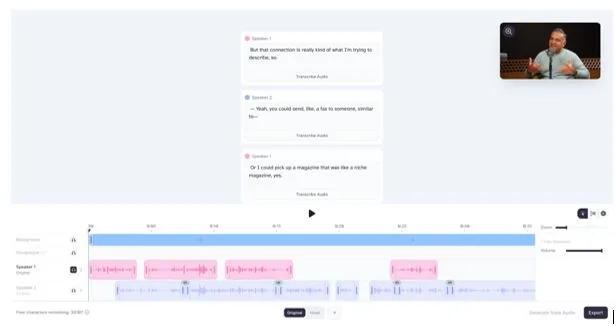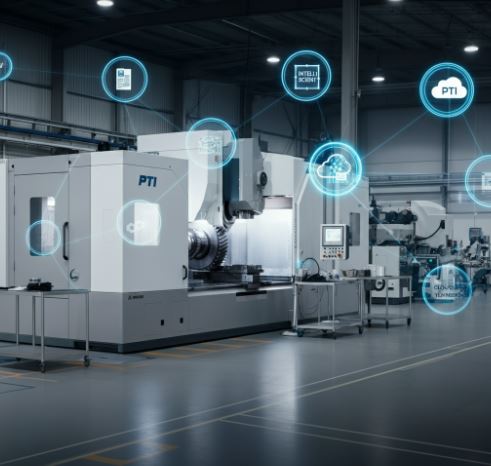Behind the Mic: How AI Dubbing Is Enhancing Global Accessibility
How does it feel to watch a famous Indian movie while sitting in the USA, and that too, in English?
You feel connected to the story, it evokes emotions, and the cultural gap narrows. You’re not reading subtitles at the bottom of the screen. Instead, you’re immersed in the characters’ voices as if they’re speaking directly to you. That is a reality because of the technology of AI dubbing.
Today, educators, creators, businesses, and storytellers aim to reach global audiences, and AI voice dubbing is making this process easier than ever before.
Let’s examine what AI dubbing is, why you need it, how it works, and the advantages.
Understanding AI Dubbing
AI dubbing is the act of using artificial intelligence to translate, generate, and sync voice content in another language. This technology reduces the friction of booking studios, hiring multiple voice actors, and doing extensive post-production.
AI dubbing platforms offer a text-to-speech dubbing system that lets creators generate high-quality, studio-like voiceovers in multiple languages without the usual logistics. With these tools, a YouTube educator in Dubai can instantly dub their lessons into Spanish or French.
The Need for AI Dubbing in Today’s World
If you ever wonder why AI-powered voiceovers are gaining popularity, here are the compelling reasons.
1. Global content consumption is increasing
Platforms like streaming apps, social media, and eLearning platforms are delivering content to millions of people worldwide in various languages. The demand for localized content is growing rapidly. The global dubbing and voice-over market was valued at USD 132.06 billion in 2024, and is projected to reach USD 238.62 billion by 2033.
2. Time and cost constraints
The traditional dubbing processes were slow and time-consuming. They required a team of voice talent, translators, sound engineers, editors, and, most importantly, a recording studio. This increased the production cost and delayed deliveries. AI voiceovers cut out the extra steps, create voices in minutes, and save time.
3. Inclusivity and accessibility
Many viewers, like those who speak minority languages, those with hearing or vision impairments, or people who struggle with reading subtitles, are left out of watching some famous shows. But AI voiceovers and text-to-speech dubbing make content more accessible. If someone can’t read subtitles or if their reading speed is slow, a natural-sounding dubbed version is available.
4. Consistency and scalability
If you have a series of videos, e.g., educational, corporate training, or marketing campaigns, keeping the same tone and style is difficult. With AI-powered voiceovers, you choose your “voice style” so that it’s consistent throughout those videos.
5. Emergencies, real-time demand, rapid response
In a crisis, people need quick information in their own language. AI dubbing enables speedy translation and natural voiceovers, letting businesses deliver urgent updates and instructions in multiple languages within minutes.
How AI Dubbing Works: Behind the Mic
Let’s pull back the curtain and see the technical machinery and workflow that make AI dubbing, AI voice dubbing, text-to-speech dubbing, and AI-powered voiceovers possible.
1. Audio capture or transcription and speaker detection
The first step is to convert the original speech into text. It includes recognizing who speaks when, identifying different speakers if multiple people are talking. Automatic speech recognition (ASR) tools tackle this. Sometimes there’s cleanup needed if the audio quality is poor.
2. Translation or script adaptation
Once it is transcribed, it is then translated into the target language. But good translation for dubbing must account for length (to match speech timing), rhythm, idioms, and cultural nuances. Some systems are “isochrony-aware” (they try to match the timing of speech in the source and translated versions) to ensure lip sync and natural pacing.
3. Voice generation or synthesis
This is where text-to-speech models or voice cloning come in. A system may choose to recreate the original speaker’s voice (if legal/permission allows) or select a synthetic voice preset. Modern AI voice models replicate inflections, emotional tone, and emphasis. They also do pitch, speed, and style adjustments.
4. Lip-sync and timing alignment
The key to making dubbed content feel natural is matching the translated voice with the mouth movements and pauses of the original video. This means aligning durations, adjusting for longer or shorter translations, and stretching/contracting audio slightly without degrading quality. The dubbing tools use some algorithms to match the audio to the video.
5. Quality assurance
The best AI needs some refinement from humans. Experts review whether the translation matches the intent. They also review whether the dubbed dialogues are culturally correct, the pronunciations are accurate, the emotional delivery is aligned, and the sync is good.
Even as these tools advance, industry leaders acknowledge the potential risks of AI, as highlighted in this news story.
6. Export or distribution
Finally, the dubbed version is exported in the desired video formats, with multiple language tracks. Creators may choose to publish with subtitles or not. Platforms allow a preview before the final release, so there’s not a single chance of error.
Benefits of AI Dubbing for Global Accessibility
We know the behind-the-scenes with AI dubbing. Now, let us look at some of the benefits of AI dubbing.
1. Wider reach and inclusion
When content is available in multiple languages, more people can access it. This includes non-native speakers, minority language groups, or those who cannot easily read subtitles.
For example, YouTube recently expanded its automatic / AI-powered dubbing to hundreds of thousands of channels offering knowledge and information content. The dubs support many languages.
2. Faster delivery or timely content
In domains like news, public service announcements, or health communication, time matters. AI voice dubbing systems can produce localized voiceovers in hours rather than weeks, which means messages are delivered without any delay.
3. Cost reduction
AI dubbing is not that costly; therefore, organizations without massive budgets, like NGOs, educators, and small creators, can even localize content. This democratizes accessibility. It means that content for underserved regions becomes feasible.
4. Improved engagement
Your audience tends to engage more when content is in their native language. Marketing videos with dubbing see significantly higher viewer completion rates.
5. Cultural relevance
Quality AI dubbing workflows allow adaptation. Choosing accents, regional idioms, and ensuring translations reflect local culture is a necessary component of AI dubbing tools. This improves comprehension and audience comfort.
Give Voice to a Global Audience
AI dubbing is the new sensation and is reshaping how stories, lessons, and messages travel across borders. It reduces costs and delivery times to make content inclusive for diverse and underserved audiences. Tools like AI voice dubbing, text-to-speech dubbing, and AI-powered voiceovers are breaking language barriers.
The journey behind the mic is ultimately about accessibility and connection. By combining speed, cultural sensitivity, and humanlike performance, AI dubbing is ensuring that content feels authentic.
If you want to stay updated on how AI is shaping media, communication, and global access, visit Big News Network for more news.





